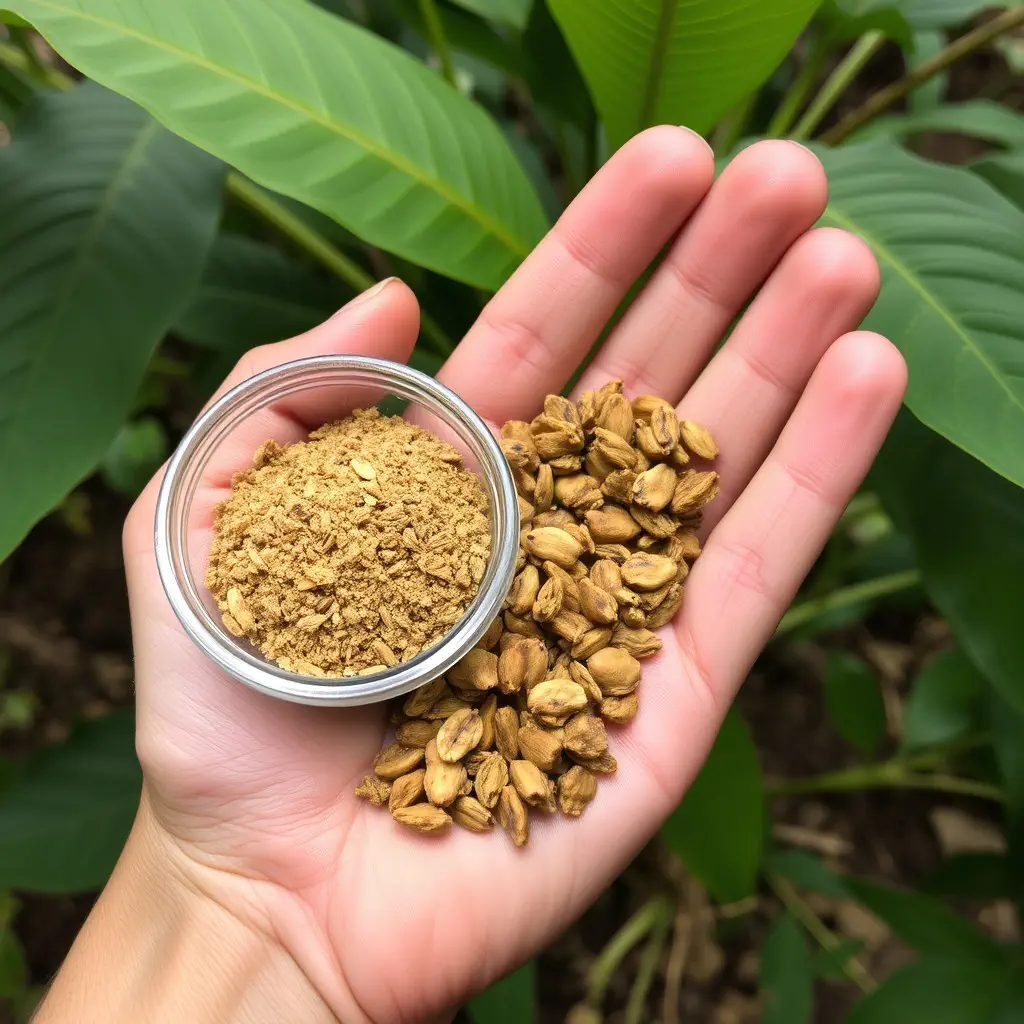Kratom, derived from the Mitragyna speciosa tree, has garnered attention as a potential aid in opioid addiction recovery due to its ability to ease withdrawal symptoms and manage cravings. Its alkaloids interact with opioid receptors, offering pain relief and an alternative to traditional opioids with a lower risk of harm. The duration of kratom's effects is a key factor, typically starting within 10 minutes after consumption and lasting from three to over six hours, depending on the dosage and strain. This extended effect can provide sustained relief without frequent redosing. However, its role in addiction treatment is under debate; while some praise it as a harm reduction tool, others caution against its use due to insufficient clinical evidence and the potential for dependency and abuse. It's crucial for individuals to consult healthcare professionals and follow scientific advancements when considering kratom as part of their recovery process, carefully weighing its benefits and risks. The effects of kratom can vary based on ingestion method, individual metabolism, tolerance, and specific strains, with the half-life ranging from 23 to 47 hours, which affects how long it remains detectable in the body. This variability underscores the importance of understanding kratom's pharmacology for safe and effective integration into addiction recovery programs, alongside a comprehensive treatment approach that includes evidence-based practices and ongoing monitoring by healthcare providers.
Kratom, a botanical derivative from the leaves of Mitragyna speciosa, has garnered attention for its potential role in addiction treatment and recovery. As communities seek effective strategies to combat substance use disorders, the exploration of alternative treatments, including kratom, is paramount. This article delves into the multifaceted impact of kratom, addressing its therapeutic properties and its integration within a comprehensive recovery plan. We will examine the enduring effects of kratom, particularly how long do the effects last, and discuss how it can be utilized as part of a holistic approach to addiction treatment. Understanding the nuances of kratom’s influence is crucial for healthcare providers and individuals navigating the complex journey of recovery. Join us as we unravel the science behind kratom and its potential in transforming lives affected by addiction.
- Unraveling Kratom's Role in Addiction Treatment and Recovery: An Overview
- The Enduring Influence of Kratom: Understanding Its Effects and Duration
- Integrating Kratom into a Holistic Addiction Recovery Plan: Strategies and Considerations
Unraveling Kratom's Role in Addiction Treatment and Recovery: An Overview

Kratom, a plant-based substance derived from the leaves of Mitragyna speciosa, has garnered attention in the realm of addiction treatment and recovery due to its potential therapeutic properties. Proponents suggest that kratom may offer relief from withdrawal symptoms and aid in the management of cravings associated with opioid addiction. Its efficacy is attributed to its interaction with opioid receptors in the brain, which can mimic the effects of morphine or codeine while offering a safer alternative. The duration of kratom’s effects is a critical aspect to understand when considering its use in treatment protocols. Typically, the onset of kratom’s effects is relatively quick, with users reporting sensations within 10 minutes after ingestion, though this can vary based on dosage and individual metabolism. The effects can last for several hours, ranging from a few to over six hours depending on the dose and strain. This duration allows for a sustained period of symptom relief without the need for frequent redosing, which is often necessary with other treatments. As research continues to evolve, there is an ongoing debate regarding kratom’s role in addiction treatment and recovery. While some studies are promising, emphasizing its potential as a harm reduction tool or as part of a comprehensive recovery strategy, others caution against its use due to the lack of rigorous clinical trials and the potential for dependence and abuse. It is crucial for individuals considering kratom as part of their treatment plan to consult with healthcare professionals and to stay informed about the latest research findings to make an educated decision that aligns with their unique recovery journey. Understanding how long the effects of kratom last is just one piece of a complex puzzle, where the goal is to harness its benefits while mitigating potential risks.
The Enduring Influence of Kratom: Understanding Its Effects and Duration

Kratom, a plant native to Southeast Asia, has gained attention in various circles as both a therapeutic aid and a subject of scrutiny due to its psychoactive properties. The alkaloids present in kratom leaves interact with the brain’s opioid receptors, leading to a spectrum of effects that can range from stimulating to sedative, depending on the dosage and strain. Understanding how long these effects last is crucial for those exploring kratom as part of their addiction treatment and recovery regimen.
The duration of kratom’s effects is influenced by several factors, including the method of ingestion, individual metabolism, tolerance levels, and the specific strain used. Typically, the onset of effects can be rapid when consumed in forms like capsules or tea, with peak impact occurring within 10 to 90 minutes after intake. The duration of these effects can vary widely; for some individuals, the sensations may persist for three to five hours, while for others, the influence might extend up to eight hours or more. It’s also important to consider that kratom’s half-life, which is the time it takes for the body to eliminate half of the drug, can range from 23 to 47 hours. This prolonged clearance rate means that the substance’s presence in the system can be detected for a significant period post-consumption, and its effects can linger accordingly. As such, individuals utilizing kratom as part of their recovery journey should approach its use with caution, considering both the immediate and extended impacts on their well-being and adherence to any treatment plan.
Integrating Kratom into a Holistic Addiction Recovery Plan: Strategies and Considerations

Integrating Kratom into a comprehensive addiction recovery plan requires careful consideration and a nuanced understanding of its pharmacological effects, particularly in the context of opioid addiction. Kratom, derived from the leaves of the Mitragyna speciosa tree, has been used traditionally in Southeast Asia for pain management and as an energy booster. Its alkaloids, mitragynine and 7-hydroxymitragynine, interact with opioid receptors in the brain, offering both stimulant and sedative properties. When incorporating Kratom into a recovery regimen, it is essential to monitor how long its effects last, which can vary depending on dosage, individual physiology, and the specific strain of Kratom used. Typically, the onset of Kratom’s effects is relatively swift, usually within 10 to 25 minutes after ingestion, with peak effects occurring around 30 to 90 minutes later. The duration of these effects can range from approximately 4 to 6 hours, depending on the factors mentioned. This timeline should be carefully managed within a recovery program to ensure that Kratom’s therapeutic window aligns with structured support activities, such as counseling or therapy sessions. Additionally, it is crucial to approach the use of Kratom with caution, as its inclusion in a holistic plan must be balanced with evidence-based treatments and complementary therapies. The goal is to leverage Kratom’s potential benefits while minimizing risks and ensuring a supportive environment for sustained recovery. Practitioners should also stay informed about ongoing research into the efficacy and safety of Kratom, as regulatory changes and new findings could impact its use in addiction treatment.
In conclusion, the potential of Kratom as a component within addiction treatment and recovery plans is promising, particularly for individuals seeking alternatives to manage withdrawal symptoms and cravings. Understanding how long the effects of Kratom last is crucial for effective dosing and for integrating it into a comprehensive recovery strategy. As outlined in this article, careful consideration must be given to its duration of action, as well as its interaction with other treatments and the individual’s unique health profile. By approaching Kratom with a holistic mindset and considering it alongside evidence-based therapies and support systems, there is an opportunity to enhance recovery outcomes. Future research should continue to explore the nuances of Kratom’s effects to optimize its role in addiction treatment and ensure the safety and well-being of those on the path to recovery.






